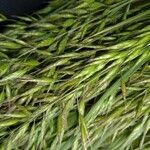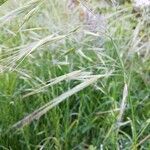Annual, caespitose. Culms 20–130 cm high. Leaves: basal sheaths pubescent to pilose; blade 5.5–17 cm long, 2–4 mm wide, pubescent to pilose. Panicles erect, contracted, 6–33.5 cm long; primary branches spreading. Spikelets erect, narrowly ovate or oblong, 10.5–20 mm long, with 5–9 bisexual florets; pedicel 3–70 mm long. Glumes unequal, keeled, with midnerve apically scaberulous to scabrous and intercostal regions glabrous; lower glume 4–5.8 mm long, 3–5-nerved; upper glume 5.2–7 mm long, 7-nerved. Callus blunt, glabrous. Basal lemma slightly laterally compressed, 6.6–8.3 mm long, with margins not tightly incurved, ±dorsally rounded, 7–9-nerved, glabrous; awn subapical, arising 0.7–1.1 mm below lemma tip, 3.5–6.5 mm long, straight (awns in upper florets sometimes slightly curved), entered by 1 or 3 nerves. Palea slightly shorter than lemma, glabrous. Anthers 1.5–2 mm long.
Annual. Culms slender, loosely tufted, erect or ascending, 25–80(–100) cm tall, glabrous or pubescent, 2–5-noded. Leaf sheaths hairy toward base, upper sheaths sparsely hairy or glabrous; leaf blades 5–30 cm × 2–8 mm, pubescent; ligule 1–3 mm. Panicle erect, narrow, 12–15 × 2–4 cm, sometimes nodding at maturity; branches 2–6 per node, lowest up to 6 cm, each bearing 1–4 spikelets. Spikelets oblong, slightly compressed, 12–20 × 4–6 mm, florets 5–10, overlapping; glumes unequal, apex acuminate, lower glume 4–6 mm, 3-veined, upper glume 4.5–7 mm, 5–7-veined; lemmas elliptic, 6–10 × 2–2.5 mm in side view, scabrid, 7–9-veined, apex obtuse, awned from ca. 1 mm below apex; awn 3–9 mm, straight; palea shorter than lemma. Anthers 1.5–3 mm. Caryopsis thin, flat, ca. 7 × 2 mm, slightly shorter than palea. Fl. and fr. Jun–Aug. 2n = 14, 28, 56.
Annual 3–10 dm, the culms usually glabrous; lower sheaths evidently hairy, the upper less so or glabrous; panicle 5–15 cm, narrow, erect or eventually nodding, with erect or strongly ascending branches; spikelets 10–15 mm, 4–10-fld; first glume 4–6 mm, the second 4–7 mm; lemmas 6.5–8 mm, elliptic or narrowly oblanceolate, rounded to a hooded tip; awn 5–9 mm, straight; palea slightly shorter than the lemma; rachilla-joints mostly 1–1.5 mm; anthers 1.5–3 mm; 2n=28. Native of Europe, occasionally intr. in disturbed sites in our range, w. to the Pacific.









